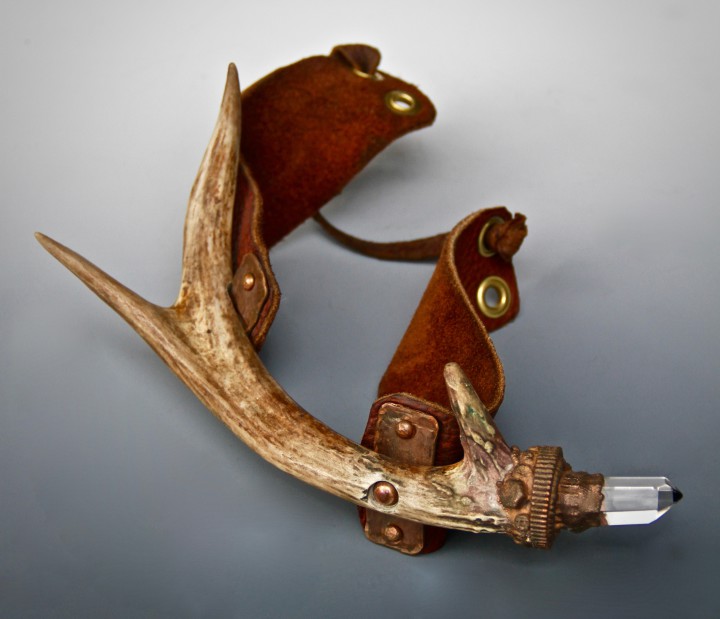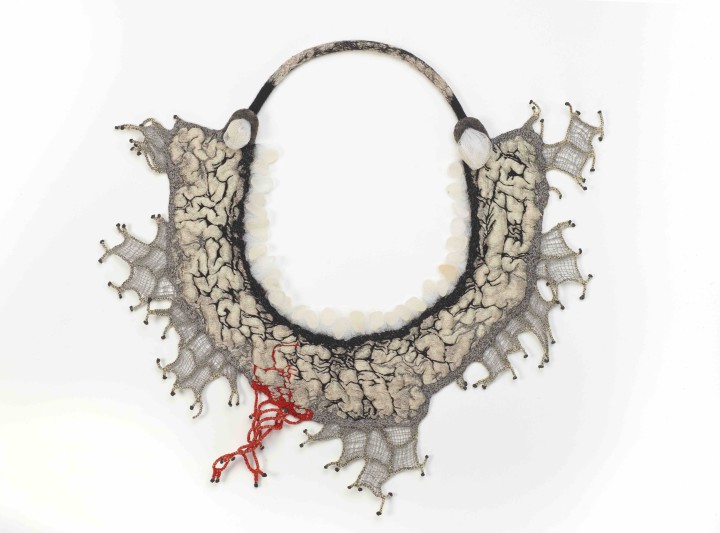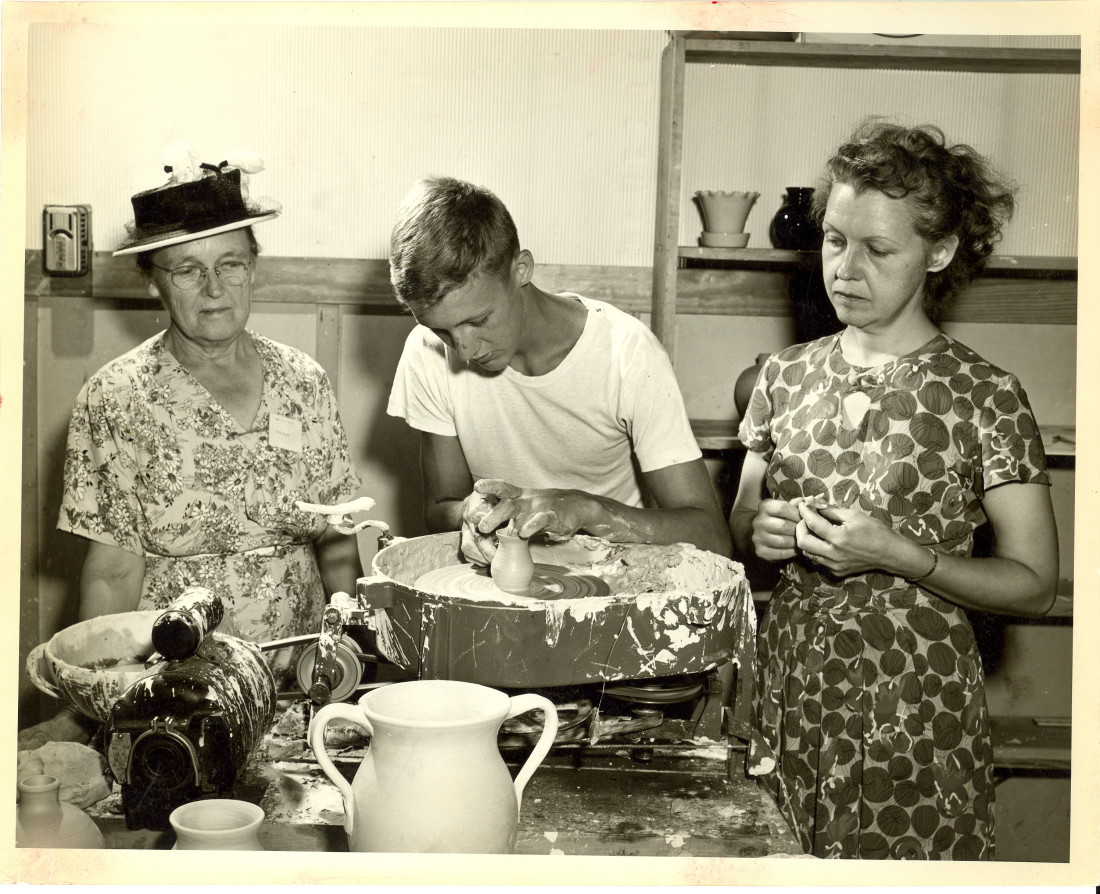The inaugural Craft Fair of the Southern Highlands took place in 1948. Artists set up in tents on the lawn of the Arrowmont School of Arts and Crafts in Gatlinburg, Tenn. There, “all the exhibitors would demonstrate within their booths … because they wanted to be sure their time was spent making their product as well as selling their product,” says Hannah Barry, director of public relations and technology at the Southern Highland Craft Guild.
The early fairs ran five to six days, for 12 hours per day — hence the need for crafters to multitask throughout the festivities, which included mountain music and dance. Taking a cue from its early iteration, today’s Craft Fair of the Southern Highlands still features demonstrations and musical acts. Held in Asheville since 1951, the institution celebrates its 70th year during its Friday, July 21, to Sunday, July 23, event at the U.S. Cellular Center.
Design in mind
Much has remained the same, but there are changes, too. This year, for example, it will run three days instead of four.
One new initiative at this year’s craft fair is a series of design vignettes during which local interior design, building and architectural firms team with guild members to “demonstrate how one can utilize craft in both form and function for the home,” according to a press release.
The concept is to show “how craft is adapting to the current trends, as well as how people can use that in their lives today,” says Barry. Plus, it places heritage traditions, such as ceramics and woodworking, within the modern home. The Cultivating Craft in Your Daily Life vignettes include a living room designed by Anne Sherrill of Rusticks and Al and Parker Platt of Platt Architecture with sculptural art basketmaker Matt Tommey; a dining room designed by Laura Sullivan of ID.ology with furniture maker Brian Boggs; and a bedroom designed by Tracey Kearnes of Alchemy Design Studio with fiber artist Barbara Zaretsky.
This season’s craft fair also includes “15 Minutes of Fashion,” created by Local Cloth. Each day at 1 p.m., models will showcase the wares of the fair’s fiber artists. “Being able to have [apparel] on a model makes it much more attractive and gives [the artists] more visibility,” says Barry.
These new initiatives are being rolled out in part to celebrate the fair’s anniversary. “To be able to have a craft fair that’s continued for that many years is huge,” says Barry. But at the same time, “We’re trying to ensure it evolves to still have relevance. What we want to work on is connecting with other people who benefit and celebrate craft.”

Futurama
Though the work of mixed-media artist Patrick Ironwood, a 2016 inductee into the guild, has eye-catching design elements, it’s not formed with an intent to lure in savvy consumers. “What I’m attempting to do is create a feeling, which a lot of art does,” he says. “But mine is about time travel and an almost spooky feeling of being in the future.”
Using soda lime and borosilicate, in addition to other materials, he takes contemporary objects and makes them look like archaeological discoveries. His booth, he says, “is a world of what the future would look like.” He adds, with a laugh, “I’m in the Southern Highland Craft Guild now, which is this heritage [organization], but I also do science fiction conventions.”
Ironwood describes his work — an innovative journey that originated with woodworking, stained glass and hot glass — as “objects that are found 500 years from now on the Eastern seaboard. People put my work in the steampunk genre, [but] it’s more like the steampunk ship went down and then, in the future, people find what’s left of the party.”
Ironwood, who grew up with crafter parents on a homestead in Tennessee, where he still lives and works, describes a new generation of craft enthusiasts who are schooled in fine art movements and connected to design through websites like Pinterest. Instead of seeking work tied to a specific tradition, they’re drawn to art that speaks to personal aesthetic. “Something’s happened in American culture where more and more people are getting released from … iconic and defined realms,” he says. “People are starting to want that feeling of freshness, and that’s superexciting.”
How we got to now
The Southern Highland Craft Guild formed in 1928 out of the efforts of Frances Goodrich, a missionary who came to Buncombe County in 1890. She founded Allanstand Cottage Industries, representing the work of area weavers and networking with leaders of the Southern arts and crafts movement.
“Chartered in 1930, it would grow to become one of the strongest craft organizations in the country,” says the guild’s website. “Second in age only to the Boston Society of Arts and Crafts, the guild now represents over 900 craftspeople in 293 counties of nine Southeastern states.”
For the last eight decades, “the guild has been trying to bring makers opportunities for commerce,” says Barry. Following the Great Depression, it grew into a marketplace organization through its brick-and-mortar retail outlets and its craft fairs. Today, “probably 50 percent of our membership is represented in our four galleries,” Barry says. That gives those crafters exposure to a large audience — the Folk Art Center itself sees more than 200,000 visitors annually.
The guild’s members range in age from the early 30s to late 60s, trending toward the 45- to 65-year-old demographic. Barry says the organization attributes this, in part, to the time it takes to become proficient in a craft, artists who discovered a second career through programs at Penland School of Crafts, John C. Campbell Folk School and similar institutions, and “members who joined in the ’90s, or before, who wanted to be a part of the guild when it was at its prime in terms of being the only opportunity for craft in the region.”
While there’s not necessarily a lot of overlap between crafters who are members of the guild and crafters who show at Asheville’s other popular biannual fair — The Big Crafty — there is a continuum between heritage and contemporary work and ideas. For instance, mixed-media artist Marty McConnaughey uses “gourds as a foundation for her craft with other natural elements like pine needles, bones or other found objects,” Barry explains. Though McConnaughey only completed the jury process last year, she represents a historic craft form. “Very few gourd makers remain in the guild,” says Barry.
And this season’s featured artist of the craft fair, ceramicist Larry Allen — a member since 1999 — is known “for his sgraffito technique inspired by Native American and African art, using special black stoneware clay,” says Barry.

Wearable sculpture
When fiber artist Lisa Klakulak first joined the craft guild in 2006, a few years after she’d relocated to the Southeast from New Mexico, “part of the reason I wanted to be in that guild was the reason I’d wanted to move to this area — because it does have that craft history,” she says. “I knew there was an educated population base that appreciated craft, as far as material understanding and process being equivalent to or even dominating the concept of what was being made.”
Klakulak uses the felting process to craft sculptural works and wearable adornments that often have a social commentary, such as her “Broken Shackles” series of cuffs. Her gauntlets — decorative fingerless gloves — were born out of an accident in which she was burned. The “reality check of the preciousness of my hands inspired the protective gauntlets,” she writes on her website.
Personal experience corresponds with time-honored technique: “I am inspired by humanity’s age-old relationship with traditional craft materials and how these materials have been transformed over time and in different cultures,” Klakulak writes in her artist statement. But her work has evolved beyond heritage methods.
In 2001, “When I first started felting and was able to conceive of the idea of sculpting through the shrinkage of wool … education had to become a major component because I had to educate the population base that I wanted to buy my work,” says Klakulak. “When I started doing more craft fairs but wasn’t teaching workshops yet, I was teaching in [my] booth. I had to explain to people what the hell they were looking at.”
These days, teaching accounts for a portion of her income. Klakulak’s upcoming courses for this year will take her across the country and to Canada; she also offers instruction in her Asheville-based Strong Felt studio.
Art meets craft
But craft pieces — even when travel, teaching and exposure to people and ideas come into play — represent the microcosm as well as the macrocosm. Klakulak turns to her work to process personal dilemmas and challenges. Current pieces are inspired by lava formations seen on a trip to Hawaii. “When I think about the texture you can get in felting, that spoke to me immediately. I could create stiff, sturdy felt, but it’s still fluid and drapable,” Klakulak says. “It doesn’t have to be fat and hairy. … You can make this sturdy material that has a ton of shrinkage so it’s dense like suede, but it’s thin enough so it has flexibility.”
She continues, “It also spoke to me about where I’m at in my life, where I feel kind of stuck, but I know there’s creative fluidity running through me. There was personal reflection going on.”
Though she finds labels unfortunate, “I refer to myself as a fine-craft artist,” says Klakulak. Her connection to the craft designation is because of the material, and, since her undergraduate studies, she’s been interested in expressing ideas through medium.
“For me, it was working with concepts around security, control and impermanence,” she says. “I found myself in fiber, which is probably the most vulnerable craft medium, as far as people investing in it, because they think it will rot or get moths or fade.” She adds, with a laugh, “It’s a funny concept to me because we’re going to do that, too!”
But fiber is also about nurturing and comfort to Klakulak, who says she walks a tightrope between art and craft. Teaching, working and showing at fairs tip her to the craft side, but there’s artistic concept in all of her pieces. “It’s a way of processing the world around me, and my experiences,” she says. “But, in a way, it’s all universal subjects. … I’m choosing things that visually represent those ideas.” So even those consumers who don’t know the story still experience the workmanship and the human connection that ensures craft remains relevant and necessary.
WHAT: Craft Fair of the Southern Highlands
WHERE: U.S. Cellular Center, 87 Haywood St.
WHEN: Friday, July 21-Sunday, July 23. Friday and Saturday, 10 a.m.-6 p.m.; Sunday, 10 a.m.-5 p.m. $12 weekend pass/$8 general admission/$5 students/free for children 12 and younger. Full schedule at craftguild.org




Before you comment
The comments section is here to provide a platform for civil dialogue on the issues we face together as a local community. Xpress is committed to offering this platform for all voices, but when the tone of the discussion gets nasty or strays off topic, we believe many people choose not to participate. Xpress editors are determined to moderate comments to ensure a constructive interchange is maintained. All comments judged not to be in keeping with the spirit of civil discourse will be removed and repeat violators will be banned. See here for our terms of service. Thank you for being part of this effort to promote respectful discussion.